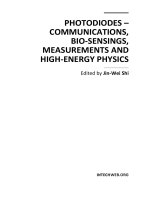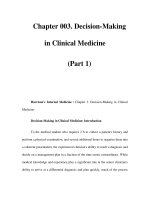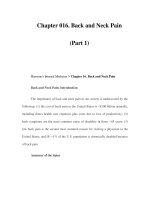Chapter 051. Menstrual Disorders and Pelvic Pain (Part 1) doc
Bạn đang xem bản rút gọn của tài liệu. Xem và tải ngay bản đầy đủ của tài liệu tại đây (12.95 KB, 5 trang )
Chapter 051. Menstrual Disorders
and Pelvic Pain
(Part 1)
Harrison's Internal Medicine > Chapter 51. Menstrual Disorders and
Pelvic Pain
Menstrual Disorders and Pelvic Pain: Introduction
Menstrual dysfunction can signal an underlying abnormality that may have
long-term health consequences. Although frequent or prolonged bleeding usually
prompts a woman to seek medical attention, infrequent or absent bleeding may
seem less troubling, and the patient may not bring it to the attention of the
physician. Thus, a focused menstrual history is a critical part of every female
patient encounter. Pelvic pain is a common complaint that may relate to an
abnormality of the reproductive organs but may also be of gastrointestinal, urinary
tract, or musculoskeletal origin. Depending on its cause, pelvic pain may require
urgent surgical attention.
Menstrual Disorders
Definition and Prevalence
Amenorrhea refers to the absence of menstrual periods. Amenorrhea is
classified as primary if menstrual bleeding has never occurred in the absence of
hormonal treatment or secondary if menstrual periods are absent for 3–6 months.
Oligoamenorrhea is defined as a cycle length >35 days or <10 menses per year.
Both the frequency and amount of vaginal bleeding are irregular in
oligoamenorrhea. It is often associated with anovulation, which can also occur
with intermenstrual intervals of <24 days or vaginal bleeding for >7 days.
Frequent or heavy irregular bleeding is termed dysfunctional uterine bleeding if
anatomic uterine lesions or a bleeding diathesis have been excluded.
Primary Amenorrhea
This is a rare disorder occurring in <1% of the female population. However,
between 3 and 5% of women experience at least 3 months of secondary
amenorrhea in a given year. There is no evidence that race or ethnicity influence
the prevalence of amenorrhea. However, because of the importance of adequate
nutrition for normal reproductive function, both the age at menarche and the
prevalence of secondary amenorrhea vary significantly in different parts of the
world.
The absence of menses by age 16 has been used traditionally to define
primary amenorrhea. However, other factors such as growth, secondary sexual
characteristics, the presence of cyclic pelvic pain, and the secular trend to an
earlier age of menarche, particularly in African-American girls, also influence the
age at which primary amenorrhea should be investigated. Thus, an evaluation for
amenorrhea should be initiated by age 15 or 16 in the presence of normal growth
and secondary sexual characteristics; age 13 in the absence of secondary sexual
characteristics or if height is less than the third percentile; age 12 or 13 in the
presence of breast development and cyclic pelvic pain; or within 2 years of breast
development if menarche has not occurred.
Secondary Amenorrhea or Oligoamenorrhea
Anovulation and irregular cycles are relatively common for 2–4 years after
menarche and for 1–2 years before the final menstrual period. In the intervening
years, menstrual cycle length is ~28 days, with an intermenstrual interval normally
ranging between 25 and 35 days. Cycle-to-cycle variability in an individual
woman who is consistently ovulating is generally +/– 2 days. Pregnancy is the
most common cause of amenorrhea and should be excluded early in any
evaluation of menstrual irregularity. However, many women will occasionally
miss a single period. Three or more months of secondary amenorrhea should
prompt an evaluation, as should a history of intermenstrual intervals of >35 or <21
days, or bleeding that persists for >7 days.
Diagnosis
Evaluation of menstrual dysfunction depends on understanding the
interrelationships between the four critical components of the reproductive tract:
(1) the hypothalamus, (2) the pituitary, (3) the ovaries, and (4) the uterus and
outflow tract (Fig. 51-1; Chap. 341). This system is maintained by complex
negative and positive feedback loops involving the ovarian steroids (estradiol and
progesterone) and peptides (inhibin B and inhibin A) and the hypothalamic
[gonadotropin-releasing hormone (GnRH)] and pituitary [follicle-stimulating
hormone (FSH) and luteinizing hormone (LH)] components of this system (Fig.
51-1).









